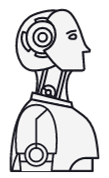The study of nanotechnology has significantly extended in recent years and established many new and interesting applications in this field. Developing nanoscale robots such as nanobots is one of those vital applications. The nanoparticles are unique as they are of 1 to 100 nanometers. The unique small scale provides a wide range of properties that can further expand into many innovative technologies. The nanotechnology industry is achieving more traction day by day and many experts think that it will reach a global net worth of more than $33.63 billion approximately in the year 2030.
Nowadays, nanobots are working in the field of biomedicine to get maximum benefit. Moreover, it also made significant advancements in cancer diagnosis and drug delivery. As per the record, these nanobots’ market value was $5.3 billion in 2021 globally. Thus, there is no doubt that this industry will expand vastly in the next decade.
Example of nanobots:
Xenobots are an important example of nanobots that will help you understand this technology well. It has been established recently that is of size less than 1 mm. Moreover, it is made up of 500-1000 living cells. These nanorobots are created in distinctive basic shapes as some even have legs. According to its developers, the xenobots can even move linearly or also circularly. The xenobots act collectively and work to move tiny objects and they live for only 10 days.
In this case, many scientists said that this aspect of nanorobots has the potential to positively impact humans, animals, and also environmental health. Thus, they will be introduced as programmable living robots that are basically made up of living organic tissues.
Replicated xenobots:
The exciting part is that the scientists who developed xenobots have successfully built the xenobots that can reproduce. Moreover, the replicated nanobots will be of completely new form of biological reproduction. The team is performing deep research on the mechanism of replicated nanobots. But still, it is believed that they will also be used as some positive means as in treating cancer, traumatic brain injury, birth defects, and in many more ways like this.
But, there is still uncertainty to some extent because of ethics. Still, the scientist showed their excitement of seeing its potential of working in cleaning the microplastics from the ocean by scavenging the toxins and radioactive materials from dangerous places. They also believe that they can perform effective targeted delivery of drugs efficiently and can repair cells and tissues.
Use of nanobots in cancer diagnosis:
The early diagnosis of cancer is a key strategy in the fight of doctors against cancer. But, because of the nature of cancer, all the present diagnostic techniques have their limitations. For instance, previously a doctors used a technique to early diagnose cancer that measured some biomarkers. However, this technique has a limitation as there are new concentrations of biomarkers in the body fluids.
Thus, nanotechnology has introduced a way that is very sensitive and specific for early diagnostics of cancer significantly. Scientists are developing a nanobot that will precisely measure cancer biomarkers even at low concentration levels. Thus, it would help them to detect various types of cancer and also overcome the limitations of previous methods.
In addition to this, researchers have even made a foldable DNA nanobot that can precisely detect and image tumor-related biomarkers in living cells. The nanorobot has two nanoparticles, connected with a DNA aptamer, serving as a biorecognition tool.
A research team in Maharashtra Institute of Medical Education and Research in Pune, India succeded in creating a magnetic nanobot that will detect the cancer cells in the circulating blood effectively. This development may result in a low-cost way of early diagnosis of cancer.
A scientist in Switzerland made a nanorobot that has the ability to navigate by the blood vessels and deliver cancer therapeutics directly to the disease area. However, this development is still in its early stages as how the nanobot is directed with ultrasound specifically in cancers that are difficult to treat locations, for example in glioblastomas.
Nanobots use in precision medicine:
Many scientists are exploring the potential of DNA nanobots for destroying cancer cells. They have programmed strands of DNA that can move through the blood and deliver blood-clotting drugs to the site of the tumor to cut their blood supply and prevent growth. Nanobots certainly have a potential future in drug delivery according to recent research.
The current progress of this technology is highlighting the surprising potential of nanobots in delivering drugs accurately and effectively. So, it will significantly help in minimizing the harmful side effects of therapeutics.
In this aspect, a research team experimented with nanobots to visualize the movement of nanobots by utilizing optical microscopy and PET (Positron Emission Tomography).
Nanobots transforming the hygiene routines:
In the future, mundane however vital tasks such as brushing the teeth will be performed with automatic nanobots. At the University of Pennsylvania, scientists have a shape shifting microswarm that can do brushing, flossing, and rinsing by nanobots.
This innovation depends on self-assembling the iron nanoparticles that easily adapt according to the shape of teeth and gum in a magnetic field. Nanoparticles make free radicals to remove pathogens. The experts said that this technology is as effective as traditional brushing and flossing.
Development of a “Global superbrain”:
At last, comes an innovative development of a global super brain. In this nanotechnology will transfer human thoughts theoretically to AI (Artificial Intelligence). That can referred to as a human “brain cloud interface”.
Scientists believe that in the future nanobots will wirelessly transmit the information from the brain to a cloud-based supercomputer network. Thus, it will facilitate real-time data extraction and brain state monitoring. But before the development of this technology, many essential steps should be focused for instance: the significant phase of research, design, and especially overcoming the ethical and moral implications of the technology.



